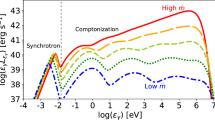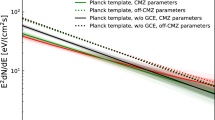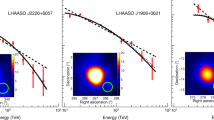Abstract
RECENT theoretical studies have shown the need for observations of isotropic cosmic gamma radiation in the 1–100 MeV energy region. Such observations will enable us to determine the relative importance of the various processes which may produce the observed isotropic X-radiation below 1 MeV and gamma radiation above 100 MeV. The first process to be examined as a possible explanation for the radiation below 1 MeV was Compton interactions between metagalactic cosmic ray electrons and photons of the universal microwave radiation field1–4. Recently, we discussed additional processes which may be important in producing extragalactic gamma radiation. These processes are cosmic ray electron bremsstrahlung with intergalactic matter5, collisions of cosmic ray nuclei with intergalactic matter which result in the production of pi-mesons6,7, and the mutual annihilation of matter and antimatter on possible boundary regions of baryon inhomo-geneity in the universe8. Our purpose here is to discuss some implications of these studies in distinguishing the gamma ray spectra produced by the various processes and placing upper limits on the metagalactic cosmic ray electron and nuclear fluxes. In particular, the results indicate that observational studies of isotropic gamma radiation between 1 and 100 MeV are critical for determining the dominant processes producing gamma rays in the metagalaxy and their cosmological implications.
This is a preview of subscription content, access via your institution
Access options
Subscribe to this journal
Receive 51 print issues and online access
$199.00 per year
only $3.90 per issue
Buy this article
- Purchase on Springer Link
- Instant access to full article PDF
Prices may be subject to local taxes which are calculated during checkout
Similar content being viewed by others
References
Hoyle, F., Phys. Rev. Lett., 15, 131 (1965).
Gould, R. J., Phys. Rev. Lett., 15, 511 (1965).
Fazio, G. G., Stecker, F. W., and Wright, J. P., Astrophys. J., 144, 611 (1966).
Felten, J. E., Phys. Rev. Lett., 15, 1003 (1965).
Silk, J., and McCray, R. C., Astrophys. Lett. (in the press).
Stecker, F. W., Nature, 220, 675 (1968). and corrections. Nature (in the press).
Stecker, F. W., Astrophys. J. (in the press).
Stecker, F. W., Nature, 221, 425 (1969). and corrections. Nature (in the press).
Stecker, F. W., Smithsonian Astrophys. Obs. Sp. Rpt. No. 260 (1967).
Stecker, F. W., Tsuruta, S., and Fazio, G. G., Astrophys. J., 151, 881 (1968).
Oort, J. H., Eleventh Solvay Conf. Brussels, Stoops, 180 (1958).
Longair, M. S., Mon. Not. Roy. Astron. Soc., 133, 421 (1966).
Tanaka, Y., Canad. J. Phys., 46, S536 (1968).
Ginzburg, V. L., and Syrovatskii, S. I., The Origin of Cosmic Rays (Macmillan Co., New York, 1964).
Felten, J. E., and Morrison, P., Astrophys. J., 146, 686 (1966).
Clark, G. W., Garmire, G. P., and Kraushaar, W. L., Astrophys. J. Lett., 153, L203 (1968).
Metzger, A. E., Anderson, E. C., van Dilla, M. A., and Arnold, J. R., Nature, 204, 766 (1964).
Author information
Authors and Affiliations
Additional information
An erratum to this article is available at https://doi.org/10.1038/2221157a0
Rights and permissions
About this article
Cite this article
STECKER, F., SILK, J. Predictions of Extragalactic Gamma Ray Fluxes between 1 and 100 MeV. Nature 221, 1229–1231 (1969). https://doi.org/10.1038/2211229b0
Received:
Published:
Issue Date:
DOI: https://doi.org/10.1038/2211229b0
This article is cited by
-
Consequences of a Universal Cosmic-ray Theory for γ-ray Astronomy
Nature (1973)
-
Diffuse Cosmic Gamma rays: Present Status of Theory and Observations
Nature Physical Science (1973)
-
Infrared Background and Universal Cosmic Rays
Nature Physical Science (1971)
-
Antimatter and Astrophysics
Nature Physical Science (1971)
-
Origin and Composition of Ultrahigh Energy Cosmic Rays
Nature Physical Science (1971)
Comments
By submitting a comment you agree to abide by our Terms and Community Guidelines. If you find something abusive or that does not comply with our terms or guidelines please flag it as inappropriate.



